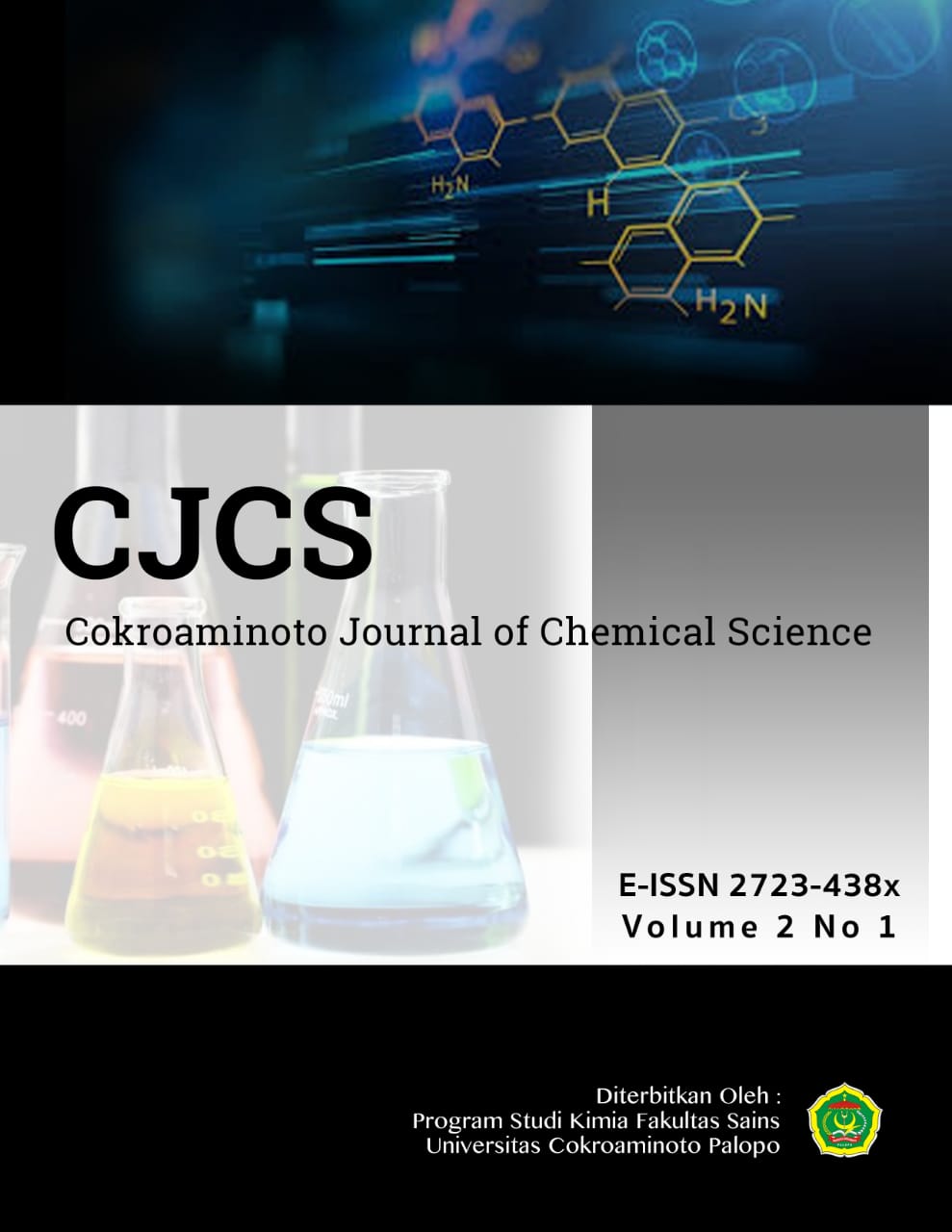ANALISIS PROKSIMAT KARBON AKTIF LIMBAH SERAT SAGU TERAKTIVASI KOH
Keywords:
sago fiber, activated carbon, KOH, hydrothermal, Metroxylon sagoAbstract
Research on the proximate carbon analysis of sago fiber waste has been carried out. This study aims to determine the chemical properties of sago fiber activated carbon. Activated carbon was prepared using the hydrothermal cabonization method. Activation is carried out chemically using KOH and followed by calcination at a temperature of 500°C. Proximate analysis was carried out to determine the chemical properties of the carbon produced. In this study, the water, ash, volatile and bonded carbon content were 6.67%, 21.22%, 17.8% and 45.79%, respectively.
Downloads
Download data is not yet available.
References
[1] N. Nurmalasari and N. Afiah, “Briket Kulit Batang Sagu (Metroxylon sagu) Menggunkan Perekat Tapioka dan Ektrak Daun Kapuk (Ceiba pentandra),” Dinamika, vol. 8, no. 1, Art. no. 1, Sep. 2017.
[2] R. Rahmi, S. Fachruddin, and N. Nurmalasari, “Pemanfaatan Limbah Serat Sagu (Metroxylon sago) Sebagai Adsorben Iodin,” J. Rekayasa Kim. Lingkung., vol. 13, no. 1, Art. no. 1, May 2018, doi: 10.23955/rkl.v13i1.10072.
[3] S. Naduparambath and E. Purushothaman, “Sago seed shell: determination of the composition and isolation of microcrystalline cellulose (MCC),” Cellulose, vol. 23, no. 3, pp. 1803–1812, Jun. 2016, doi: 10.1007/s10570-016-0904-3.
[4] S. Hartanto and R. Ratnawati, “PEMBUATAN KARBON AKTIF DARI TEMPURUNG KELAPA SAWIT DENGAN METODE AKTIVASI KIMIA,” J. Sains Materi Indones., vol. 12, no. 1, Art. no. 1, Oct. 2010, doi: 10.17146/jsmi.2010.12.1.4588.
[5] H. Kristianto, “REVIEW: SINTESIS KARBON AKTIF DENGAN MENGGUNAKAN AKTIVASI KIMIA ZnCL2,” J. INTEGRASI PROSES, vol. 6, no. 3, Art. no. 3, Jun. 2017, doi: 10.36055/jip.v6i3.1031.
[6] W. Kusmaningrum and I. Nurhayati, “Penggunaan Karbon Aktif dari Ampas Tebu Sebagai Media Adsorbsi untuk Menurunkan Kadar Fe (Besi) dan Mn (Mangan) pada Air Sumur Gali di Desa Gelam Candi,” WAKTU J. Tek. UNIPA, vol. 14, no. 1, Art. no. 1, Jan. 2016.
[7] L. Efiyanti, S. Wati, and M. Maslahat, “Pembuatan dan Analisis Karbon Aktif dari Cangkang Buah Karet dengan Proses Kimia dan Fisika,” J. Ilmu Kehutan., vol. 14, p. 94, Jul. 2020, doi: 10.22146/jik.57479.
[8] “Pengaruh Variasi Suhu Karbonisasi Terhadap Karakteristik Karbon Aktif Dari Bambu Swat (Gigantocholoa verticillata) | Teknik Desain Mekanika,” Accessed: Nov. 03, 2020. [Online]. Available: https://ojs.unud.ac.id/index.php/mekanika/article/view/44053.
[9] G. Pari, K. Sofyan, W. Syafii, B. Buchari, and H. Yamamoto, “KAJIAN STRUKTUR ARANG DARI LIGNIN,” J. Penelit. Has. Hutan, vol. 24, no. 1, Art. no. 1, 2006, doi: 10.20886/jphh.2006.24.1.9-20.
[2] R. Rahmi, S. Fachruddin, and N. Nurmalasari, “Pemanfaatan Limbah Serat Sagu (Metroxylon sago) Sebagai Adsorben Iodin,” J. Rekayasa Kim. Lingkung., vol. 13, no. 1, Art. no. 1, May 2018, doi: 10.23955/rkl.v13i1.10072.
[3] S. Naduparambath and E. Purushothaman, “Sago seed shell: determination of the composition and isolation of microcrystalline cellulose (MCC),” Cellulose, vol. 23, no. 3, pp. 1803–1812, Jun. 2016, doi: 10.1007/s10570-016-0904-3.
[4] S. Hartanto and R. Ratnawati, “PEMBUATAN KARBON AKTIF DARI TEMPURUNG KELAPA SAWIT DENGAN METODE AKTIVASI KIMIA,” J. Sains Materi Indones., vol. 12, no. 1, Art. no. 1, Oct. 2010, doi: 10.17146/jsmi.2010.12.1.4588.
[5] H. Kristianto, “REVIEW: SINTESIS KARBON AKTIF DENGAN MENGGUNAKAN AKTIVASI KIMIA ZnCL2,” J. INTEGRASI PROSES, vol. 6, no. 3, Art. no. 3, Jun. 2017, doi: 10.36055/jip.v6i3.1031.
[6] W. Kusmaningrum and I. Nurhayati, “Penggunaan Karbon Aktif dari Ampas Tebu Sebagai Media Adsorbsi untuk Menurunkan Kadar Fe (Besi) dan Mn (Mangan) pada Air Sumur Gali di Desa Gelam Candi,” WAKTU J. Tek. UNIPA, vol. 14, no. 1, Art. no. 1, Jan. 2016.
[7] L. Efiyanti, S. Wati, and M. Maslahat, “Pembuatan dan Analisis Karbon Aktif dari Cangkang Buah Karet dengan Proses Kimia dan Fisika,” J. Ilmu Kehutan., vol. 14, p. 94, Jul. 2020, doi: 10.22146/jik.57479.
[8] “Pengaruh Variasi Suhu Karbonisasi Terhadap Karakteristik Karbon Aktif Dari Bambu Swat (Gigantocholoa verticillata) | Teknik Desain Mekanika,” Accessed: Nov. 03, 2020. [Online]. Available: https://ojs.unud.ac.id/index.php/mekanika/article/view/44053.
[9] G. Pari, K. Sofyan, W. Syafii, B. Buchari, and H. Yamamoto, “KAJIAN STRUKTUR ARANG DARI LIGNIN,” J. Penelit. Has. Hutan, vol. 24, no. 1, Art. no. 1, 2006, doi: 10.20886/jphh.2006.24.1.9-20.
Downloads
Published
2020-11-03
How to Cite
[1]
Nurmalasari, A. . Mulyasari, Risna, Surianti, and Diana, “ANALISIS PROKSIMAT KARBON AKTIF LIMBAH SERAT SAGU TERAKTIVASI KOH”, CJCS, vol. 2, no. 1, pp. 18–20, Nov. 2020.
Issue
Section
Articles
License
In submitting the manuscript to the journal, the authors certify that:
- They are authorized by their co-authors to enter into these arrangements.
- The work described has not been formally published before, except in the form of an abstract or as part of a published lecture, review, thesis, or overlay journal.
- That it is not under consideration for publication elsewhere,
- That its publication has been approved by all the author(s) and by the responsible authorities – tacitly or explicitly – of the institutes where the work has been carried out.
- They secure the right to reproduce any material that has already been published or copyrighted elsewhere.
- They agree to the following license and copyright agreement.
License and Copyright Agreement
Authors who publish with this journal agree to the following terms:
- Authors retain copyright and grant the journal right of first publication with the work simultaneously licensed under Creative Commons Attribution License (CC BY 4.0) that allows others to share the work with an acknowledgment of the work's authorship and initial publication in this journal.
- Authors are able to enter into separate, additional contractual arrangements for the non-exclusive distribution of the journal's published version of the work (e.g., post it to an institutional repository or publish it in a book), with an acknowledgment of its initial publication in this journal.
- Authors are permitted and encouraged to post their work online (e.g., in institutional repositories or on their website) prior to and during the submission process, as it can lead to productive exchanges, as well as earlier and greater citation of published work.

